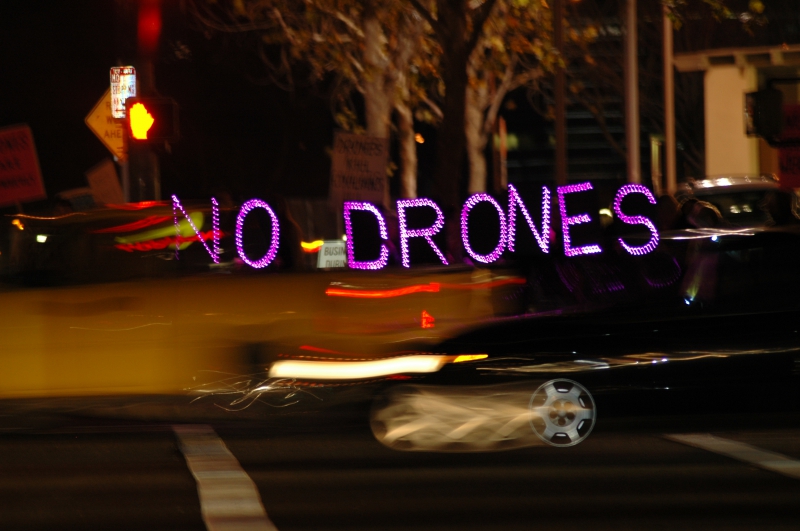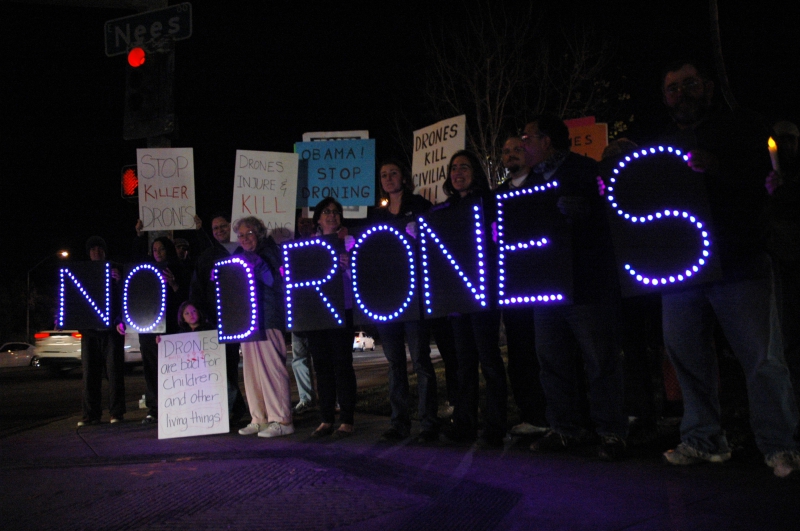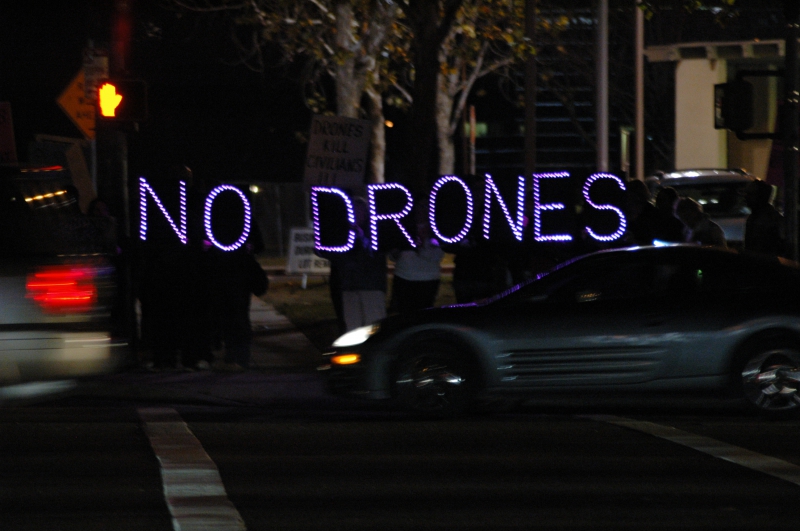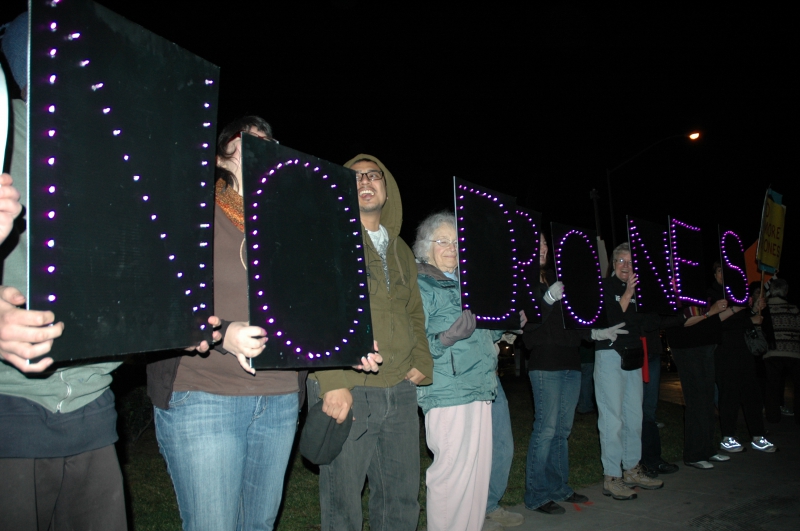From the Open-Publishing Calendar
From the Open-Publishing Newswire
Indybay Feature
No Drones - Fresno demo
Photos from the Peace Fresno NO DRONES demonstration on February 1, 2013 at Nees and Blackstone. The lighted message (below) on the No Drone sign(s) are visible from a block away. This photo was shot with an extended exposure to let extra light in as a car zoomed by.
Background info about the No Drones demonstration, from the Peace Fresno Press Release:
FOR IMMEDIATE RELEASE
Contact: Name: Mike Bridges (Board Member)
phone number: 559-452-7852
e-mail address: mikebridges126 [at] comcast.net
or
Contact: Name: Beverly Fitzpatrick (President)
phone number: 559-432-8210
e-mail address: dfitzpatrick29 [at] comcast.net
Peace Fresno says, NO DRONES
-- http://www.peacefresno.org/ -- https://www.facebook.com/PeaceFresno
On Friday February 1st, from 6:45pm until 7:30pm Peace Fresno will have a Light Brigade action featuring the message NO DRONES. The lighted message will be on the northeast corner of Blackstone and Nees along with citizens supporting peace and demonstrating against the military industrial complex that perpetuates war for profit.
The address for the In-N-Out on that corner is 8010 N. Blackstone Fresno, Ca 93720.
http://maps.google.com/maps?q=36.851943,-119.790834&num=1&t=m&z=19
-In the United States, the dominant narrative about the use of drones is of a surgically precise and effective tool that makes the US safer by enabling “targeted killing” of terrorists, with minimal downsides or collateral impacts. This narrative is false.
Real threats to US security exist in areas now targeted by drones, but it is essential that public debate about US policies take the negative effects of current policies into account.
While civilian casualties are rarely acknowledged by the US government, there is significant evidence that US drone strikes have injured and killed civilians. The government continues to shield the drone program from democratic accountability.
The best currently available public aggregate data on drone strikes are provided by The Bureau of Investigative Journalism (TBIJ), an independent journalist organization. TBIJ reports that from June 2004 through mid-September 2012, available data indicate that drone strikes killed 2,562-3,325 people in Pakistan, of whom 474-881 were civilians, including 176 children. TBIJ reports that these strikes also injured an additional 1,228-1,362 individuals. Rarely is any information provided about the victims or the communities they leave behind.
Drones fly over communities, striking homes, vehicles, and public spaces without warning. Their presence terrorizes men, women, and children, giving rise to anxiety and psychological trauma among civilian communities. Those living under drones have to face the constant worry that a deadly strike may be fired at any moment, and the knowledge that they are powerless to protect themselves. These fears have affected behavior. The US practice of striking one area multiple times, and evidence that it has killed rescuers, makes both community members and humanitarian workers afraid or unwilling to assist injured victims. Some community members shy away from gathering in groups, including important tribal dispute-resolution bodies, out of fear that they may attract the attention of drone operators. Some parents choose to keep their children home, and children injured or traumatized by strikes have dropped out of school.
Publicly available evidence that the strikes have made the US safer overall is ambiguous at best. The strikes have certainly killed alleged combatants and disrupted armed actor networks. However, serious concerns about the efficacy and counter-productive nature of drone strikes have been raised. The number of “high-level” targets killed as a percentage of total casualties is extremely low—estimated at just 2%. Evidence suggests that US strikes have facilitated recruitment to violent non-state armed groups, and motivated further violent attacks. As the New York Times has reported, “drones have replaced Guantánamo as the recruiting tool of choice for militants.” Drone strikes have also soured many Pakistanis on cooperation with the US and undermined US-Pakistani relations. One major study shows that 74% of Pakistanis now consider the US an enemy.
Current US targeted killings and drone strike practices undermine respect for the rule of law and international legal protections and may set dangerous precedents. The US government’s failure to ensure basic transparency and accountability in its targeted killing policies, to provide necessary details about its targeted killing program, or adequately to set out the legal factors involved in decisions to strike hinders necessary democratic debate about a key aspect of US foreign and national security policy. US practices may also facilitate recourse to lethal force around the globe by establishing dangerous precedents for other governments. As drone manufacturers and officials successfully reduce export control barriers, and as more countries develop lethal drone technologies, these risks increase.
· The US should fulfill its international obligations with respect to accountability and transparency, and ensure proper democratic debate about key policies.
· The US should:
· Release the US Department of Justice memoranda outlining the legal basis for US targeted killing in Pakistan;
Make public critical information concerning US drone strike policies, including as previously and repeatedly requested by various groups and officials.
· The US should fulfill its international humanitarian and human rights law obligations with respect to the use of force, including by not using lethal force against individuals who are not members of armed groups with whom the US is in an armed conflict, or otherwise against individuals not posing an imminent threat to life. This includes not double-striking targets as first responders arrive.
· Journalists and media outlets should cease the common practice of referring simply to “militant” deaths, without further explanation. All reporting of government accounts of “militant” deaths should include acknowledgment that the US government counts all adult males killed by strikes as “militants,” absent exonerating evidence. Media accounts relying on anonymous government sources should also highlight the fact of their single-source information and of the past record of false government reports.
CIA Drone Strikes in Pakistan 2004–2013
Total US strikes: 362
Obama strikes: 310
Total reported killed: 2,629-3,461
Civilians reported killed: 475-891
Children reported killed: 176
Total reported injured: 1,267-1,431
US Covert Action in Yemen 2002–2013
Total confirmed US operations (all): 54-64
Total confirmed US drone strikes: 42-52
Possible extra US operations: 132-154
Possible extra US drone strikes: 74-90
Total reported killed (all): 374-1,096
Total civilians killed (all): 72-175
Children killed (all): 27-35
US Covert Action in Somalia 2007–2013
Total US strikes: 10-23
Total US drone strikes: 3-9
Total reported killed: 58-170
Civilians reported killed: 11-57
Children reported killed: 1-3
http://www.thebureauinvestigates.com/category/projects/drones/
FOR IMMEDIATE RELEASE
Contact: Name: Mike Bridges (Board Member)
phone number: 559-452-7852
e-mail address: mikebridges126 [at] comcast.net
or
Contact: Name: Beverly Fitzpatrick (President)
phone number: 559-432-8210
e-mail address: dfitzpatrick29 [at] comcast.net
Peace Fresno says, NO DRONES
-- http://www.peacefresno.org/ -- https://www.facebook.com/PeaceFresno
On Friday February 1st, from 6:45pm until 7:30pm Peace Fresno will have a Light Brigade action featuring the message NO DRONES. The lighted message will be on the northeast corner of Blackstone and Nees along with citizens supporting peace and demonstrating against the military industrial complex that perpetuates war for profit.
The address for the In-N-Out on that corner is 8010 N. Blackstone Fresno, Ca 93720.
http://maps.google.com/maps?q=36.851943,-119.790834&num=1&t=m&z=19
-In the United States, the dominant narrative about the use of drones is of a surgically precise and effective tool that makes the US safer by enabling “targeted killing” of terrorists, with minimal downsides or collateral impacts. This narrative is false.
Real threats to US security exist in areas now targeted by drones, but it is essential that public debate about US policies take the negative effects of current policies into account.
While civilian casualties are rarely acknowledged by the US government, there is significant evidence that US drone strikes have injured and killed civilians. The government continues to shield the drone program from democratic accountability.
The best currently available public aggregate data on drone strikes are provided by The Bureau of Investigative Journalism (TBIJ), an independent journalist organization. TBIJ reports that from June 2004 through mid-September 2012, available data indicate that drone strikes killed 2,562-3,325 people in Pakistan, of whom 474-881 were civilians, including 176 children. TBIJ reports that these strikes also injured an additional 1,228-1,362 individuals. Rarely is any information provided about the victims or the communities they leave behind.
Drones fly over communities, striking homes, vehicles, and public spaces without warning. Their presence terrorizes men, women, and children, giving rise to anxiety and psychological trauma among civilian communities. Those living under drones have to face the constant worry that a deadly strike may be fired at any moment, and the knowledge that they are powerless to protect themselves. These fears have affected behavior. The US practice of striking one area multiple times, and evidence that it has killed rescuers, makes both community members and humanitarian workers afraid or unwilling to assist injured victims. Some community members shy away from gathering in groups, including important tribal dispute-resolution bodies, out of fear that they may attract the attention of drone operators. Some parents choose to keep their children home, and children injured or traumatized by strikes have dropped out of school.
Publicly available evidence that the strikes have made the US safer overall is ambiguous at best. The strikes have certainly killed alleged combatants and disrupted armed actor networks. However, serious concerns about the efficacy and counter-productive nature of drone strikes have been raised. The number of “high-level” targets killed as a percentage of total casualties is extremely low—estimated at just 2%. Evidence suggests that US strikes have facilitated recruitment to violent non-state armed groups, and motivated further violent attacks. As the New York Times has reported, “drones have replaced Guantánamo as the recruiting tool of choice for militants.” Drone strikes have also soured many Pakistanis on cooperation with the US and undermined US-Pakistani relations. One major study shows that 74% of Pakistanis now consider the US an enemy.
Current US targeted killings and drone strike practices undermine respect for the rule of law and international legal protections and may set dangerous precedents. The US government’s failure to ensure basic transparency and accountability in its targeted killing policies, to provide necessary details about its targeted killing program, or adequately to set out the legal factors involved in decisions to strike hinders necessary democratic debate about a key aspect of US foreign and national security policy. US practices may also facilitate recourse to lethal force around the globe by establishing dangerous precedents for other governments. As drone manufacturers and officials successfully reduce export control barriers, and as more countries develop lethal drone technologies, these risks increase.
· The US should fulfill its international obligations with respect to accountability and transparency, and ensure proper democratic debate about key policies.
· The US should:
· Release the US Department of Justice memoranda outlining the legal basis for US targeted killing in Pakistan;
Make public critical information concerning US drone strike policies, including as previously and repeatedly requested by various groups and officials.
· The US should fulfill its international humanitarian and human rights law obligations with respect to the use of force, including by not using lethal force against individuals who are not members of armed groups with whom the US is in an armed conflict, or otherwise against individuals not posing an imminent threat to life. This includes not double-striking targets as first responders arrive.
· Journalists and media outlets should cease the common practice of referring simply to “militant” deaths, without further explanation. All reporting of government accounts of “militant” deaths should include acknowledgment that the US government counts all adult males killed by strikes as “militants,” absent exonerating evidence. Media accounts relying on anonymous government sources should also highlight the fact of their single-source information and of the past record of false government reports.
CIA Drone Strikes in Pakistan 2004–2013
Total US strikes: 362
Obama strikes: 310
Total reported killed: 2,629-3,461
Civilians reported killed: 475-891
Children reported killed: 176
Total reported injured: 1,267-1,431
US Covert Action in Yemen 2002–2013
Total confirmed US operations (all): 54-64
Total confirmed US drone strikes: 42-52
Possible extra US operations: 132-154
Possible extra US drone strikes: 74-90
Total reported killed (all): 374-1,096
Total civilians killed (all): 72-175
Children killed (all): 27-35
US Covert Action in Somalia 2007–2013
Total US strikes: 10-23
Total US drone strikes: 3-9
Total reported killed: 58-170
Civilians reported killed: 11-57
Children reported killed: 1-3
http://www.thebureauinvestigates.com/category/projects/drones/
For more information:
http://www.peacefresno.org
We are 100% volunteer and depend on your participation to sustain our efforts!
Get Involved
If you'd like to help with maintaining or developing the website, contact us.
Publish
Publish your stories and upcoming events on Indybay.
Topics
More
Search Indybay's Archives
Advanced Search
►
▼
IMC Network







